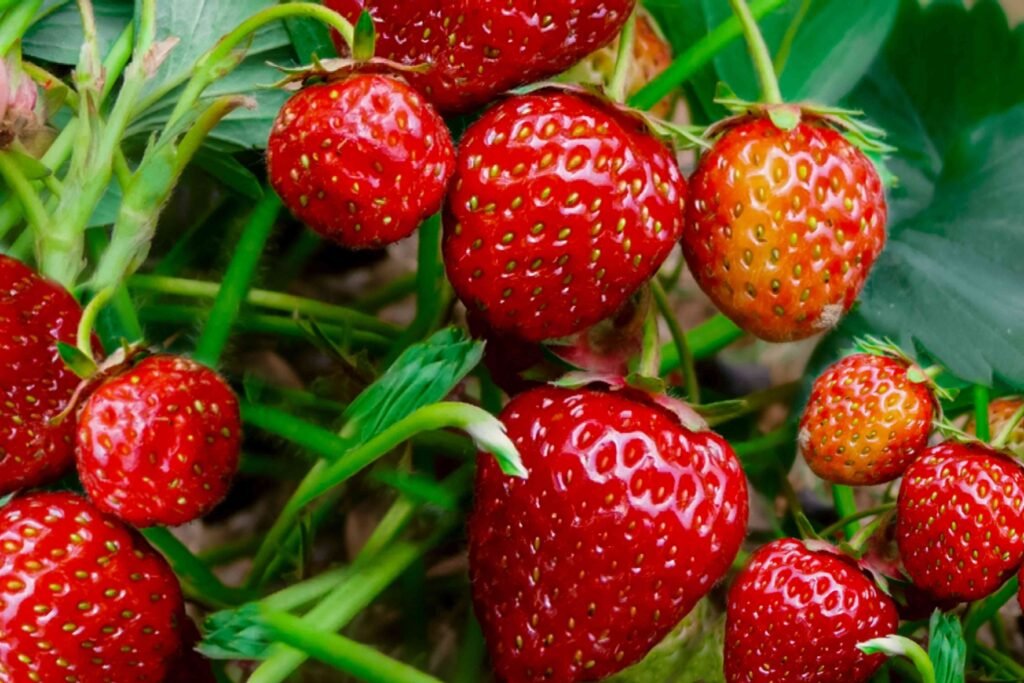The strawberry is a beloved fruit enjoyed worldwide for its sweet, juicy flavor and vibrant red color. Known for its fragrant aroma and a perfect balance of sweetness and tartness, strawberries are a popular choice for snacking, desserts, salads, and beverages. As one of the most recognizable fruits, strawberries have a rich history of cultivation dating back centuries. In addition to their appealing taste, strawberries are packed with essential nutrients, including antioxidants, vitamins, and fiber. Whether fresh or used in cooking and baking, strawberries bring a burst of flavor and nutrition to various dishes.

Origin and History:
Strawberries have a long history, with wild varieties being found in Europe and the Americas. The modern cultivated strawberry (Fragaria × ananassa) is a hybrid of North American and South American species, developed in Europe in the 18th century. Strawberries have been enjoyed by many cultures for thousands of years, with their use dating back to ancient Roman times. Today, they are grown in temperate regions around the world, and strawberries are available year-round due to their global production.
Varieties:
There are numerous varieties of strawberries, each with its unique flavor profile and size. Some common types include:
- June-bearing Strawberries: These are the most common variety, producing a large, concentrated crop in early summer.
- Ever-bearing Strawberries: Known for producing fruit multiple times a year, often in spring, summer, and fall.
- Day-neutral Strawberries: These plants produce strawberries throughout the growing season, providing fruit consistently from spring to fall.
- Wild Strawberries: Smaller and more intensely flavored, these strawberries are native to various parts of the world and are often found in forested areas.
Nutritional Value (per 100g of raw strawberry):
- Calories: 32 kcal
- Carbohydrates: 7.7g
- Dietary Fiber: 2g
- Sugars: 4.9g
- Protein: 0.7g
- Fat: 0.3g
- Vitamin C: 58.8mg (about 65% of the recommended daily intake)
- Potassium: 153mg
- Folate: 24µg (important for cell growth and DNA synthesis)
Health Benefits:
- Rich in Antioxidants: Strawberries are loaded with antioxidants, including vitamin C, anthocyanins, and ellagic acid, which help protect the body from oxidative stress and inflammation.
- Supports Immune Health: The high vitamin C content in strawberries boosts the immune system, aiding in the prevention of infections and supporting wound healing.
- Promotes Heart Health: Strawberries help improve heart health by reducing the risk of cardiovascular disease. The antioxidants in strawberries contribute to improved blood vessel function, while their high potassium content helps regulate blood pressure.
- Improves Skin Health: The vitamin C in strawberries plays a key role in collagen production, promoting skin health and helping to reduce wrinkles and fine lines.
- Aids in Digestion: Strawberries are rich in fiber, particularly pectin, which helps support digestive health by regulating bowel movements and maintaining gut bacteria balance.
Culinary Uses:
Strawberries are highly versatile and can be used in a wide variety of dishes:
- Fresh Consumption: Strawberries are commonly eaten raw, either whole or sliced, and added to fruit salads, yogurt, or simply enjoyed on their own.
- Desserts: Strawberries are used extensively in desserts like strawberry shortcake, strawberry tarts, pies, and ice cream. They also pair well with whipped cream or chocolate.
- Smoothies and Beverages: Strawberries are frequently blended into smoothies, milkshakes, and fruit juices for their natural sweetness and flavor.
- Baking: Strawberries are incorporated into baked goods such as muffins, cakes, and bread, where their juiciness adds both flavor and moisture.
- Savory Dishes: Strawberries can be used in savory dishes, such as salads, where their sweetness pairs well with balsamic vinegar, cheese, and leafy greens.
Storage:
Strawberries are best stored in the refrigerator to maintain their freshness. They should be kept in a shallow container to prevent crushing and should not be washed until just before use. If you have an excess of ripe strawberries, they can be frozen for later use in smoothies or baking. Simply wash, hull, and freeze them in a single layer before transferring them to an airtight container.
Fun Facts:
- Despite their name, strawberries are not true “berries” from a botanical standpoint. True berries, such as blueberries, develop from a single flower ovary, whereas strawberries are considered “aggregate fruits” because they form from multiple ovaries.
- The average strawberry contains about 200 tiny seeds on its surface.
- Strawberries were once used as a medicinal plant to treat ailments like digestive issues and inflammation.
- The world’s largest strawberry shortcake, weighing over 30,000 pounds, was made in 2009 in the United States.
